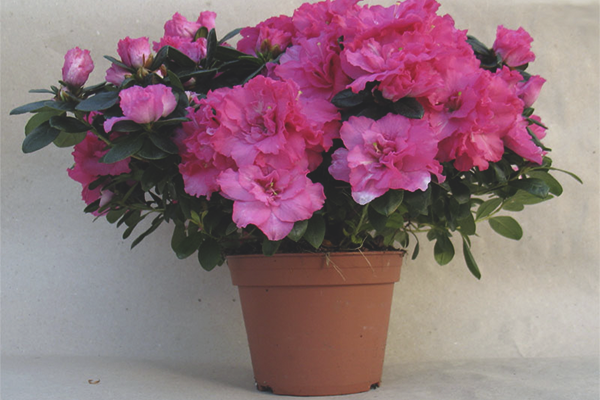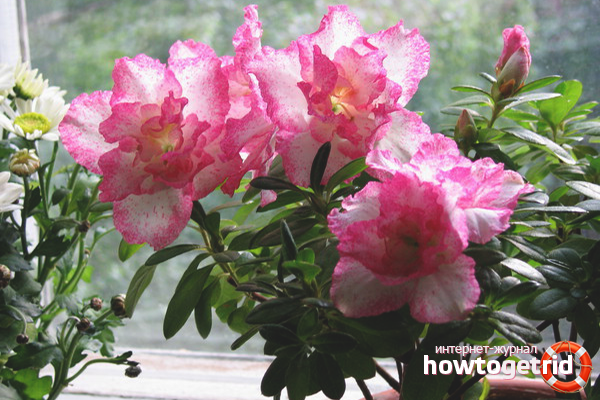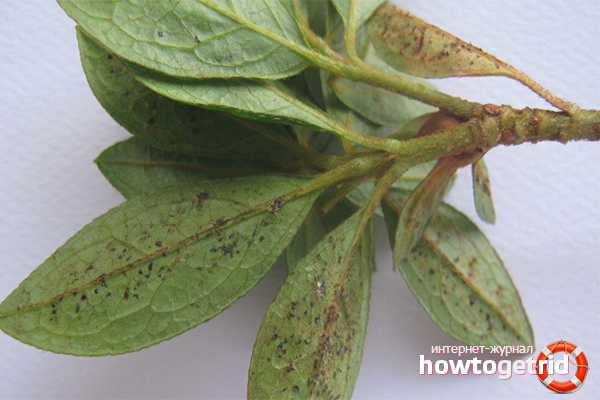The content of the article
Caring for azaleas is quite difficult even for experienced gardeners, what can we say about beginners. However, the effort is worth it! The capricious plant amazes with variety of coloring, grace and originality of forms, pomp of flowering. From such beauty it is difficult to tear off a look.
In order for this luxurious flower to continue to delight the eye with its flowering and not to wither, it is necessary to exert maximum efforts to maintain it in proper condition. The undoubted advantage of azaleas over other indoor plants is that its activity falls on the cold season.
Shrub species
East Asia, the Caucasus and the mountainous regions of the Carpathians are considered to be the birthplace of a luxurious evergreen plant: areas with a mild climate and fertile soils.Such climatic conditions have a positive effect on the shrub, which, with all the desire can not be called unpretentious, and contribute to its development.
Azalea, translated from Greek, its name sounds like "dry", is a plant that reaches a height of 40 centimeters to one and a half meters (depending on the type). At rest - nondescript shrub with rough, shallow and dry foliage. But when the azalea begins to bloom, its fabulously beautiful flowers visually resemble roses.
At home, it is customary to grow two types of azaleas: Indian and Japanese. Among gardeners, garden azalea is also very popular, the cultivation of which differs little from indoor varieties.
Indian is more adapted for keeping at home. Its height reaches 60 centimeters, flowering time lasts two months: from December to February. Its flowers are larger than the Japanese, but the latter can be used after flowering as an ornamental evergreen shrub. Japanese azalea is not distinguished by the splendor of flowers, its advantage is a rich green crown.
Maintaining the right temperature in the room
One of the important points for the safe functioning of azaleas is the appropriate temperature in the room.
Many growers complain sadly that immediately after the first flowering the azalea shed the leaves and dried. It is not surprising, because the shrub does not tolerate either heat or cold, these natural or artificially created phenomena are extremely dangerous for him. Therefore, choosing a place where the plant will be located, should take into account the natural environment of its habitat. These should be cool places with clean air and diffused sunlight.
It is very important to maintain the required temperature in the room. The best for stimulating azalea flowering is considered to be the temperature from + 10 to + 15, but not more than + 18 degrees. From the heaters, the azalea should be placed as far as possible. It is necessary to air the room more often - drafts for the plant are not terrible. Windows should face north, east or west.
In winter, for example, azalea can be moved to a warmed loggia, where it will be quite comfortable.
It is important to know the two most important points, it is a guarantee of the successful development of the plant:
- The optimum temperature in the room during the formation of the plant buds should not be below +5 degrees. When the azalea begins to bloom, the temperature will need to be gradually increased.
- If the room is too hot, experienced flower growers are advised to dip the flower in cool water or cover it with ice cubes.
Correct watering
Azalea is imported from countries with a humid climate, therefore, the land in which it grows should not be dry, it is necessary to moisten the soil. However, the plant should not swim in water, it will destroy it.
When watering should follow the following rules:
- The colder in the room, the less often the shrub should be watered and, conversely, the hotter it is, the more often it is recommended to irrigate the soil with water.
- If the ground is dry, the pot should be immersed in a basin of water for 2-3 hours. Watering azaleas is recommended to resume only after three days.
- Spraying and watering is done only with cold boiled water.
- In the summer hot period, you need to water at least 2 times a day and systematically spray the leaves.
Never use ordinary water from the tap for watering azaleas! Apply settled thawed, rain and distilled.
When buds are laid, watering should be less. A lack of water can cause the azalea to lose its foliage and turn yellow. No less harmful to her and excess water, it is fraught with rotting of the root system.
How to create the right lighting
Despite the fact that azalea loves heat, it should be prudently protected from bright sunshine, the room with diffused lighting is best suited to it. Otherwise, the leaves of the tender plant can get burned, it manifests itself in the form of dry twisted tips. If the room is small and you can put a pot with an azalea only on the window sill, whose window faces south, then the shrub needs to be closed from the hot sunshine with a plastic sheet with a matte surface. So the twilight will be created in the room, which is so necessary for a capricious plant.
In the cold period, azalea, by contrast, lacks light. Following the example of experienced gardeners, you can install an additional electric light near the pot.
Indoor air humidity
But what azalea loves is a humid environment that needs to be maintained indoors, although it is difficult.To do this, a pot with shrubs to put in a large basin filled with cool water. Moss or pebbles should be poured into the tray first.
If the air in the room is too dry, then the azalea leaves should be periodically sprayed with water using a spray bottle (at least twice a day). It is necessary to try that the drops are very small, otherwise the plant will be covered with spots.
Fertilization
Without the use of special tools in the care of azalea is indispensable. With the onset of summer, the shrub is treated with nitrogenous fertilizers, starting in August and ending with the flowering period, phosphate and potash fertilizers are used. Fertilizing should be done every two weeks, you can not neglect this process, as the plant may die. When choosing a tool, it is recommended to consult with a specialist and follow the recommendations written on the fertilizer package exactly. The consequences of a non-dosed top dressing can be unpredictable, even to the death of a plant.
It is necessary to maintain the level of acidity of the soil and water the azalea with a solution of citric acid (1 tsp. Per 2 liters of water).Water should have a slightly sour taste.
As an additional food it is desirable to use superphosphate. Fertilizers make better in the evening.
Azalea bloom
For this wonderful period, the azalea can be turned and moved for convenience, but after that the plant pot should be returned to its original position and not touch the buds and flowers. Flowers that have bloomed need to be removed immediately, otherwise azaleas will have to spend strength on seed ripening. In the faded azalea, crown formation occurs.
If the correct temperature is maintained, flowering will last up to 2.5 months, if not, it will last only 2 weeks.
If an azalea that is already in bloom is purchased in the store, it should have several formed flowers.
After flowering
In order for the beautiful plant to continue to delight you with its beautiful lush flowers, you need to take proper care for it at the end of the flowering period. An important point is the timely transfer of the shrub into the new pot, you must first remove the faded flowers, young shoots, dry leaves and branches.Only soil intended for rhododendrons is used.
The reason for the transplant is the overgrown root system or the rotting of the substrate.
The transplant procedure needs to be done to a young plant once a year, to an adult 3 times. The pot should be free, but shallow, as the azalea belongs to the surface plants. Loosen the soil is not recommended so as not to damage the roots.
Reproduction occurs by cutting. Cuttings harvested either in spring (March-April) or in summer (July-August). In both cases, the plant must be pinched last year.
Cuttings are harvested only from healthy plants and no more than 1 time per year. To do this, make an undercut under the lower kidney of a semi-lignified shoot 7-10 cm long. The lower leaves are cut off completely, the upper leaves are cut in half. Cut the cuttings in a bundle and put in a solution of heteroauxin or root of the lower cut. Drain after 6 hours in a container with prepared soil.
At room temperature after 2 months, the cuttings will give roots. When using special heating, this will happen in 20-25 days.
As soon as the cuttings have taken root, they should be transplanted into larger pots with coniferous soil and pinch in 2 months. This procedure is necessary for the formation of the bush.It is better to remove the first buds, they prevent young azaleas from developing. Pinching and trimming should be done in a timely manner. Pruning is done immediately after flowering, when you need to cut wildly overgrown shoots and form a crown, so that it does not become too spreading. Pinching stimulates flowering.
Azalea diseases
Lack of good care can trigger bush disease. Violation of the temperature regime, untimely or excessive moisture, illiterately chosen fertilizers and non-compliance with the dosage during feeding are direct sources of health hazard to the delicious azalea.
Azalea afflictions are determined by the following symptoms. Early intervention will help correct the situation:
- The foliage has faded and fallen - the lack of watering or contact with the plant in direct sunlight.
- The flowers turned yellow and fell off - the use of bad water.
- The appearance of cobwebs, yellowness and abscission of buds - spider mite infestation, the pest appears with insufficient air moistening and watering. Shrubs should be washed first with soap and then rinsed thoroughly with warm water.
- Young leaves take the form of a tube, many small buds form instead of 2-3 large ones, the flowers do not open, the plant either does not grow at all, or grows very slowly - the plant is attacked by a strawberry mite. To deal with it is very difficult and possible only with the help of special means from pests.
The beautiful azalea is a very capricious plant, but with expert care, she will thank her host for a wonderful flowering.
Video: how to properly care for azalea















To send